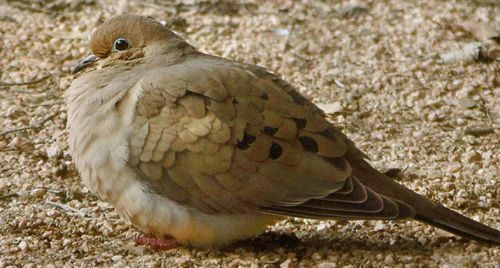by Valerie
January, 2015Mourning Dove
Of the common doves in our neighborhood, the mourning dove (Zenaida macroura) is the most elegant looking. Its long pointed tail is distinctive as it zooms through the air with its characteristic straight, fast flight. The bird shown above appears much chubbier than usual because it is fluffed up against a cold morning. Though not as numerous as the white-winged doves, whose huge flocks tend to dominate our area, mourning doves are still rather common; I often see them foraging and sometimes find their nests. They seem to prefer balancing a few twigs on a branch of our tall juniper or Chinese parasol trees, but I've also found a nest on a low ledge of a vine-covered building where I walk our dog. The birds are quite tolerant of human presence, and I've been surprised to suddenly be looking eye-to-eye with a dove on its half-hidden nest at a distance of just a couple of feet. During the summer, the doves are attracted to our ponds and seem rather oblivious to my presence when they land. If I don't move, they never seem to know I am around. While most birds drink by scooping water into their beaks and then tipping their heads back to swallow, doves use suction so they simply lower their heads to the water and drink continuously. Mourning dove nestlings are ugly to the point of being charming, with their emerging feathers sticking out like quills. The newly hatched babies are fed crop milk for a few days. This substance is a sort of whitish glop produced by glands in the parents' crops and is often compared to the milk produced by mammals because it contains antibodies and nutrients. |